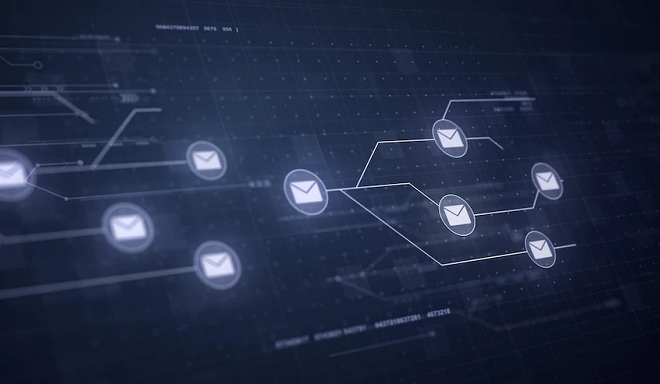When reaching and winning customers via email, it’s safe to say that a single message doesn’t do the trick. A Woodpecker study found that sending four to seven emails in a sequence generated an average response rate of 27%, while sending one to three messages got a reply rate of 9%. This study proves that consistency and persistence are key to successful email outreach.
Before we introduce you to two effective email follow-up and nurture sequences you can use to convert prospects into customers, we’ll explain what an email sequence is and why every lead acquisition manager and sales rep should set up at least one.
All right, let’s get started!
First Things First: What’s an Email Sequence?
An email sequence is a series of emails sent from automation software to an existing or potential customer. Here, the emails are sent based on predetermined conditions to stimulate the recipient’s interest and get them to take the desired action (reply, sign up, or make a purchase).
Running email marketing sequences is always a smart choice, but especially if:
- You’re copy-pasting the same email pitch to every prospect
- You spend a chunk of your workday drafting, scheduling, and sending follow-up emails
- You often forget to follow up
Designing and implementing email marketing sequences is easier than it might seem. With the right email marketing tool, you’ll be able to build your sequences from scratch and schedule them to be delivered in the recipient’s time zone. You only need to set things up once!
Automating your email marketing sequences will help you reach countless prospects, maintain consistency with your messaging, and free up time to focus on other tasks.
Still not sure if you understand what an email sequence is. No worries; the following two examples will help you understand what an email series looks like. Feel free to put them both to the test.
Example #1: Cold Sales Email Follow-up Sequence
Overlooking the follow-up sequence is one of the most common and expensive mistakes sales reps make when sending cold emails. While sending an enticing initial message is important, it’s crucial to remember that most sales happen due to gentle follow-up emails.
To increase your chances of success, we recommend building a sales email follow-up sequence of at least five separate messages (including the initial cold email). Here’s what ours looks like:
- An attention-grabbing opening cold email
- A gentle follow-up email a few days after the initial message
- A value bringer 3-4 days after the first follow-up message
- A second value bringer 3-4 days after the first value bringer message
- A break-up email 4-5 days after the second value bringer message
Cold Sales Email
When writing a cold sales email, there are a few simple yet powerful tips you should follow:
- Come up with an intriguing but credible subject line (avoid spam trigger words)
- Include an irresistible offer (add relevant figures and stats)
- Incorporate client case studies, success stories, and testimonials to back up your claims
Need some inspiration? Here’s a great cold sales email example:
Subject Line: Close more deals faster
Dear Timothy,
I saw you recently downloaded our eBook on delivering next-level personalization in B2B marketing. Since my team and I have worked with dozens of companies in the finance industry, I decided to reach out.
OakNorth Bank seems like a great fit for SalesIntel, and I’d love to hear what you have planned for the next 18 months.
At SalesIntel, we help businesses like yours achieve their marketing and sales goals by:
- Providing you with accurate, verified-by-humans, B2B company and contact information
- Supplying you with buyer intent data to see who’s interested in your products/services
- Helping you convert anonymous website visitors into potential customers with our VisitorIntel solution
If you’d like to learn how SalesIntel can empower your marketing and sales teams, please get in touch with me to arrange a meeting.
I look forward to hearing from you.
Yours sincerely,
Robin Buckley
Head of Marketing at SalesIntel
Mobile: 999-999-9999
Email: robin.buckley@example.com
The Follow-up Email
Following up is an essential part of every successful sales story. Once you send a carefully crafted cold sales email, you should wait two to three days before you follow up on it. The reason is simple: you must give your prospect time to read your message and consider your offer.
If you don’t want to automate your email sequence but would rather do it manually to be on the safe side, you can use an email tracker to see when and how many times your recipient has opened your email. This information can help you decide exactly when to touch base with them.
![]()
Image source: Mailbutler.io
Moreover, when composing a follow-up email, you need to make sure not to repeat yourself. You can ask your prospect if they read your previous message and thought about your offer in the same thread. Keep it friendly and concise.
First and Second Value Bringer
To move the sales process forward, you must make your next two emails valuable and relevant to your recipient. One of the best ways to add value to your messages is to include the following:
- Case studies. Customer case studies are social proof of your offer’s value. A detailed case study shows how one of your customers used your products or services to solve a specific problem and the results. This might be exactly what your prospect needs to read to move forward.
- Success stories. Unlike case studies, success stories should be short and to the point as they’re supposed to summarize your customers’ successful experience with your company. Their goal, of course, is to pique your recipient’s curiosity and convince them to email back.
- Referrals. High-quality referrals from companies your prospect knows and respects can help you earn their trust and stand out from the crowd. There are numerous ways to get referrals from your customers, but adopting a customer loyalty program, leveraging LinkedIn, and offering sign-up or purchase incentives are some of the most effective options.
- Testimonials. Testimonials are customer statements testifying to the benefits of a product or service. They work because they’re not aggressive sales pitches. Instead, they provide credibility for your promises. Customer testimonials are often the seal of approval prospective customers need to see before starting to trust you.
- Useful content. Adding a piece or two of relevant content to your emails is another great way to offer value to your prospect, especially if you don’t have any customer stories to share. This way, you’ll show them you took the time to understand their pain points and find a solution that doesn’t necessarily involve your product or service – but could.
The Break-up Email
If your prospect doesn’t decide to purchase your product after the previous four emails, you’ll need to send them a break-up message to provoke a response. A break-up email is a must because it helps you to close the communication loop but is also a final chance to seal the deal.
When writing a break-up email, you can take one of the following approaches:
- Reinforce your interest in helping your prospect’s business (let them know they can reach out to you if they have any questions).
- Be direct and ask if they’re still interested in your product or service (keep the email short and simple).
- Remove all emotion and proactively assume the deal is lost (this will create a sense of urgency in your prospect if they’re still interested or get them to write back confirming your assumption is correct).
Example #2: Follow-up Email Sequence After a Meeting
In this scenario, you’ve already had a business meeting and/or talked over the phone with your prospect. You should follow up immediately after the meeting to solidify your positions and strengthen your relationship. This sequence is shorter than the cold sales email one but equally effective. Here’s what it consists of:
- A follow-up email right after the meeting/phone call (it should provide a brief recap of your conversation, including the goals you agreed on and the steps you need to take to achieve them).
- A second follow-up email a day after the first email (in this message, you should remind your prospect of the date and time of your next meeting and send them a list of resources to help them prepare for it).
- A third follow-up email a day before the meeting (which should serve as a gentle reminder, so they show up). You could write this as ‘just confirming we’re still meeting tomorrow at X time,’ for example.
Summary
Email sequences, particularly automated ones, make a powerful email outreach strategy because they save time, move prospects through the sales journey, and help you acquire new customers (which, in turn, boost your conversions and revenue).
Conversely, sending just one email, regardless of how engaging it is, probably won’t win you any customers. They might be too busy to reply straight away, have concerns about your offer, or forget to read your message.
Not sure how to build your first email sequence? Feel free to use and adapt the above examples to your needs. You got this!
AUTHOR BIO:
Ilija Sekulov is a Digital Marketing Consultant & Senior SEO/SEM Specialist.





